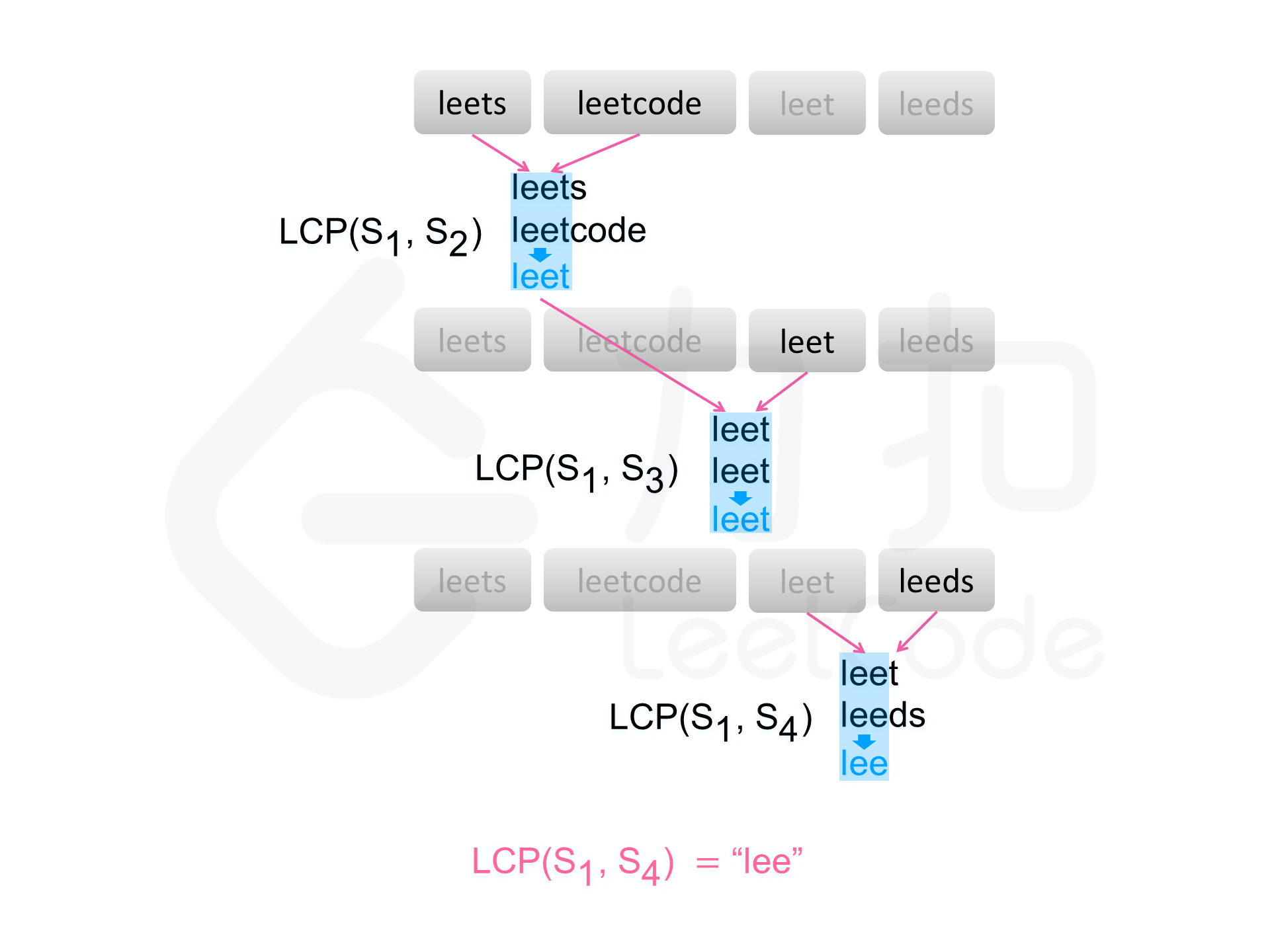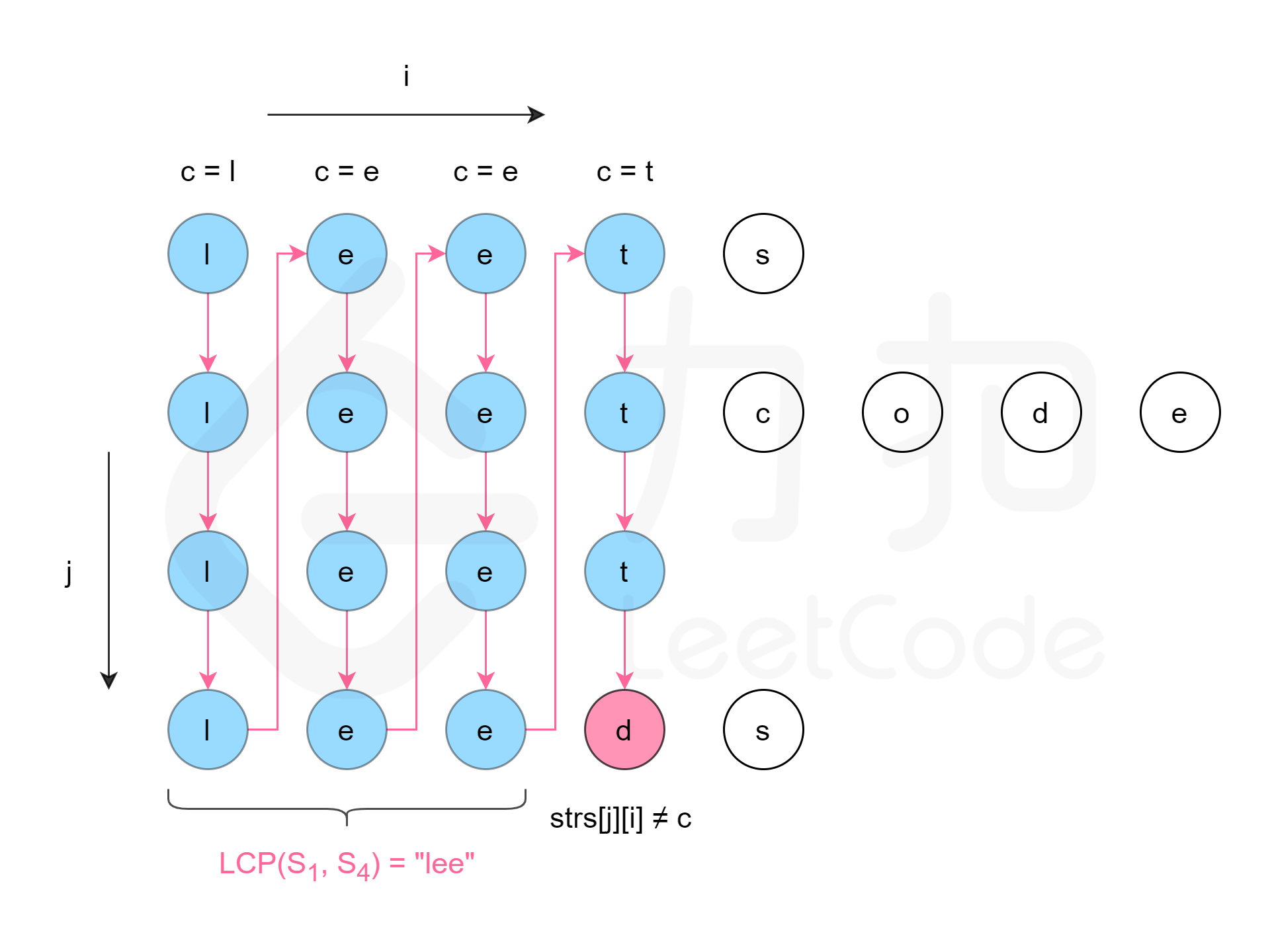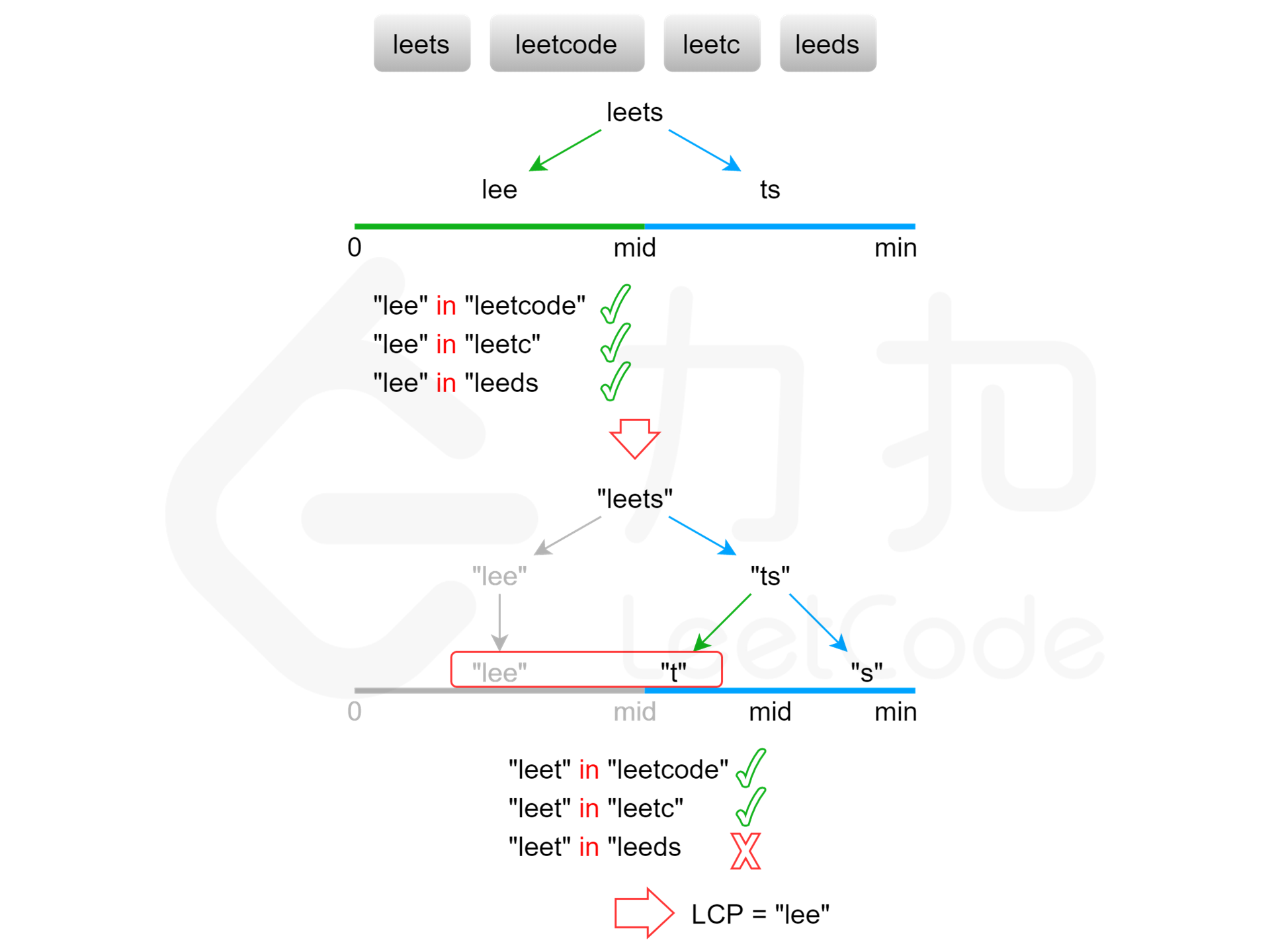编写一个函数来查找字符串数组中的最长公共前缀。
如果不存在公共前缀,返回空字符串 ""。
示例 1:
**输入:** strs = ["flower","flow","flight"]
**输出:** "fl"
示例 2:
**输入:** strs = ["dog","racecar","car"]
**输出:** ""
**解释:** 输入不存在公共前缀。
提示:
1 <= strs.length <= 2000 <= strs[i].length <= 200strs[i] 仅由小写英文字母组成
📺 视频题解
📖 文字题解 方法一:横向扫描 用 $\textit{LCP}(S_1 \ldots S_n)$ 表示字符串 $S_1 \ldots S_n$ 的最长公共前缀。
可以得到以下结论:
$$
基于该结论,可以得到一种查找字符串数组中的最长公共前缀的简单方法。依次遍历字符串数组中的每个字符串,对于每个遍历到的字符串,更新最长公共前缀,当遍历完所有的字符串以后,即可得到字符串数组中的最长公共前缀。
如果在尚未遍历完所有的字符串时,最长公共前缀已经是空串,则最长公共前缀一定是空串,因此不需要继续遍历剩下的字符串,直接返回空串即可。
[sol1-Java] 1 2 3 4 5 6 7 8 9 10 11 12 13 14 15 16 17 18 19 20 21 22 23 24 25 class Solution { public String longestCommonPrefix (String[] strs) { if (strs == null || strs.length == 0 ) { return "" ; } String prefix = strs[0 ]; int count = strs.length; for (int i = 1 ; i < count; i++) { prefix = longestCommonPrefix(prefix, strs[i]); if (prefix.length() == 0 ) { break ; } } return prefix; } public String longestCommonPrefix (String str1, String str2) { int length = Math.min(str1.length(), str2.length()); int index = 0 ; while (index < length && str1.charAt(index) == str2.charAt(index)) { index++; } return str1.substring(0 , index); } }
[sol1-C++] 1 2 3 4 5 6 7 8 9 10 11 12 13 14 15 16 17 18 19 20 21 22 23 24 25 26 class Solution {public : string longestCommonPrefix (vector<string>& strs) { if (!strs.size ()) { return "" ; } string prefix = strs[0 ]; int count = strs.size (); for (int i = 1 ; i < count; ++i) { prefix = longestCommonPrefix (prefix, strs[i]); if (!prefix.size ()) { break ; } } return prefix; } string longestCommonPrefix (const string& str1, const string& str2) { int length = min (str1.size (), str2.size ()); int index = 0 ; while (index < length && str1[index] == str2[index]) { ++index; } return str1.substr (0 , index); } };
[sol1-Python3] 1 2 3 4 5 6 7 8 9 10 11 12 13 14 15 16 17 18 class Solution : def longestCommonPrefix (self, strs: List [str ] ) -> str : if not strs: return "" prefix, count = strs[0 ], len (strs) for i in range (1 , count): prefix = self.lcp(prefix, strs[i]) if not prefix: break return prefix def lcp (self, str1, str2 ): length, index = min (len (str1), len (str2)), 0 while index < length and str1[index] == str2[index]: index += 1 return str1[:index]
[sol1-Golang] 1 2 3 4 5 6 7 8 9 10 11 12 13 14 15 16 17 18 19 20 21 22 23 24 25 26 27 28 29 30 func longestCommonPrefix (strs []string ) string { if len (strs) == 0 { return "" } prefix := strs[0 ] count := len (strs) for i := 1 ; i < count; i++ { prefix = lcp(prefix, strs[i]) if len (prefix) == 0 { break } } return prefix } func lcp (str1, str2 string ) string { length := min(len (str1), len (str2)) index := 0 for index < length && str1[index] == str2[index] { index++ } return str1[:index] } func min (x, y int ) int { if x < y { return x } return y }
复杂度分析
方法二:纵向扫描 方法一是横向扫描,依次遍历每个字符串,更新最长公共前缀。另一种方法是纵向扫描。纵向扫描时,从前往后遍历所有字符串的每一列,比较相同列上的字符是否相同,如果相同则继续对下一列进行比较,如果不相同则当前列不再属于公共前缀,当前列之前的部分为最长公共前缀。
[sol2-Java] 1 2 3 4 5 6 7 8 9 10 11 12 13 14 15 16 17 18 class Solution { public String longestCommonPrefix (String[] strs) { if (strs == null || strs.length == 0 ) { return "" ; } int length = strs[0 ].length(); int count = strs.length; for (int i = 0 ; i < length; i++) { char c = strs[0 ].charAt(i); for (int j = 1 ; j < count; j++) { if (i == strs[j].length() || strs[j].charAt(i) != c) { return strs[0 ].substring(0 , i); } } } return strs[0 ]; } }
[sol2-C++] 1 2 3 4 5 6 7 8 9 10 11 12 13 14 15 16 17 18 19 class Solution {public : string longestCommonPrefix (vector<string>& strs) { if (!strs.size ()) { return "" ; } int length = strs[0 ].size (); int count = strs.size (); for (int i = 0 ; i < length; ++i) { char c = strs[0 ][i]; for (int j = 1 ; j < count; ++j) { if (i == strs[j].size () || strs[j][i] != c) { return strs[0 ].substr (0 , i); } } } return strs[0 ]; } };
[sol2-Python3] 1 2 3 4 5 6 7 8 9 10 11 12 class Solution : def longestCommonPrefix (self, strs: List [str ] ) -> str : if not strs: return "" length, count = len (strs[0 ]), len (strs) for i in range (length): c = strs[0 ][i] if any (i == len (strs[j]) or strs[j][i] != c for j in range (1 , count)): return strs[0 ][:i] return strs[0 ]
[sol2-Golang] 1 2 3 4 5 6 7 8 9 10 11 12 13 func longestCommonPrefix (strs []string ) string { if len (strs) == 0 { return "" } for i := 0 ; i < len (strs[0 ]); i++ { for j := 1 ; j < len (strs); j++ { if i == len (strs[j]) || strs[j][i] != strs[0 ][i] { return strs[0 ][:i] } } } return strs[0 ] }
复杂度分析
方法三:分治 注意到 $\textit{LCP}$ 的计算满足结合律,有以下结论:
$$
其中 $\textit{LCP}(S_1 \ldots S_n)$ 是字符串 $S_1 \ldots S_n$ 的最长公共前缀,$1 < k < n$。
基于上述结论,可以使用分治法得到字符串数组中的最长公共前缀。对于问题 $\textit{LCP}(S_i\cdots S_j)$,可以分解成两个子问题 $\textit{LCP}(S_i \ldots S_{mid})$ 与 $\textit{LCP}(S_{mid+1} \ldots S_j)$,其中 $mid=\frac{i+j}{2}$。对两个子问题分别求解,然后对两个子问题的解计算最长公共前缀,即为原问题的解。
[sol3-Java] 1 2 3 4 5 6 7 8 9 10 11 12 13 14 15 16 17 18 19 20 21 22 23 24 25 26 27 28 29 30 class Solution { public String longestCommonPrefix (String[] strs) { if (strs == null || strs.length == 0 ) { return "" ; } else { return longestCommonPrefix(strs, 0 , strs.length - 1 ); } } public String longestCommonPrefix (String[] strs, int start, int end) { if (start == end) { return strs[start]; } else { int mid = (end - start) / 2 + start; String lcpLeft = longestCommonPrefix(strs, start, mid); String lcpRight = longestCommonPrefix(strs, mid + 1 , end); return commonPrefix(lcpLeft, lcpRight); } } public String commonPrefix (String lcpLeft, String lcpRight) { int minLength = Math.min(lcpLeft.length(), lcpRight.length()); for (int i = 0 ; i < minLength; i++) { if (lcpLeft.charAt(i) != lcpRight.charAt(i)) { return lcpLeft.substring(0 , i); } } return lcpLeft.substring(0 , minLength); } }
[sol3-C++] 1 2 3 4 5 6 7 8 9 10 11 12 13 14 15 16 17 18 19 20 21 22 23 24 25 26 27 28 29 30 31 32 33 class Solution {public : string longestCommonPrefix (vector<string>& strs) { if (!strs.size ()) { return "" ; } else { return longestCommonPrefix (strs, 0 , strs.size () - 1 ); } } string longestCommonPrefix (const vector<string>& strs, int start, int end) { if (start == end) { return strs[start]; } else { int mid = (start + end) / 2 ; string lcpLeft = longestCommonPrefix (strs, start, mid); string lcpRight = longestCommonPrefix (strs, mid + 1 , end); return commonPrefix (lcpLeft, lcpRight); } } string commonPrefix (const string& lcpLeft, const string& lcpRight) { int minLength = min (lcpLeft.size (), lcpRight.size ()); for (int i = 0 ; i < minLength; ++i) { if (lcpLeft[i] != lcpRight[i]) { return lcpLeft.substr (0 , i); } } return lcpLeft.substr (0 , minLength); } };
[sol3-Python3] 1 2 3 4 5 6 7 8 9 10 11 12 13 14 15 16 class Solution : def longestCommonPrefix (self, strs: List [str ] ) -> str : def lcp (start, end ): if start == end: return strs[start] mid = (start + end) // 2 lcpLeft, lcpRight = lcp(start, mid), lcp(mid + 1 , end) minLength = min (len (lcpLeft), len (lcpRight)) for i in range (minLength): if lcpLeft[i] != lcpRight[i]: return lcpLeft[:i] return lcpLeft[:minLength] return "" if not strs else lcp(0 , len (strs) - 1 )
[sol3-Golang] 1 2 3 4 5 6 7 8 9 10 11 12 13 14 15 16 17 18 19 20 21 22 23 24 25 26 27 28 func longestCommonPrefix (strs []string ) string { if len (strs) == 0 { return "" } var lcp func (int , int ) string lcp = func (start, end int ) string { if start == end { return strs[start] } mid := (start + end) / 2 lcpLeft, lcpRight := lcp(start, mid), lcp(mid + 1 , end) minLength := min(len (lcpLeft), len (lcpRight)) for i := 0 ; i < minLength; i++ { if lcpLeft[i] != lcpRight[i] { return lcpLeft[:i] } } return lcpLeft[:minLength] } return lcp(0 , len (strs)-1 ) } func min (x, y int ) int { if x < y { return x } return y }
复杂度分析
时间复杂度:$O(mn)$,其中 $m$ 是字符串数组中的字符串的平均长度,$n$ 是字符串的数量。时间复杂度的递推式是 $T(n)=2 \cdot T(\frac{n}{2})+O(m)$,通过计算可得 $T(n)=O(mn)$。
空间复杂度:$O(m \log n)$,其中 $m$ 是字符串数组中的字符串的平均长度,$n$ 是字符串的数量。空间复杂度主要取决于递归调用的层数,层数最大为 $\log n$,每层需要 $m$ 的空间存储返回结果。
方法四:二分查找 显然,最长公共前缀的长度不会超过字符串数组中的最短字符串的长度。用 $\textit{minLength}$ 表示字符串数组中的最短字符串的长度,则可以在 $[0,\textit{minLength}]$ 的范围内通过二分查找得到最长公共前缀的长度。每次取查找范围的中间值 $\textit{mid}$,判断每个字符串的长度为 $\textit{mid}$ 的前缀是否相同,如果相同则最长公共前缀的长度一定大于或等于 $\textit{mid}$,如果不相同则最长公共前缀的长度一定小于 $\textit{mid}$,通过上述方式将查找范围缩小一半,直到得到最长公共前缀的长度。
[sol4-Java] 1 2 3 4 5 6 7 8 9 10 11 12 13 14 15 16 17 18 19 20 21 22 23 24 25 26 27 28 29 30 31 32 33 34 35 class Solution { public String longestCommonPrefix (String[] strs) { if (strs == null || strs.length == 0 ) { return "" ; } int minLength = Integer.MAX_VALUE; for (String str : strs) { minLength = Math.min(minLength, str.length()); } int low = 0 , high = minLength; while (low < high) { int mid = (high - low + 1 ) / 2 + low; if (isCommonPrefix(strs, mid)) { low = mid; } else { high = mid - 1 ; } } return strs[0 ].substring(0 , low); } public boolean isCommonPrefix (String[] strs, int length) { String str0 = strs[0 ].substring(0 , length); int count = strs.length; for (int i = 1 ; i < count; i++) { String str = strs[i]; for (int j = 0 ; j < length; j++) { if (str0.charAt(j) != str.charAt(j)) { return false ; } } } return true ; } }
[sol4-C++] 1 2 3 4 5 6 7 8 9 10 11 12 13 14 15 16 17 18 19 20 21 22 23 24 25 26 27 28 29 30 31 32 33 34 class Solution {public : string longestCommonPrefix (vector<string>& strs) { if (!strs.size ()) { return "" ; } int minLength = min_element (strs.begin (), strs.end (), [](const string& s, const string& t) {return s.size () < t.size ();})->size (); int low = 0 , high = minLength; while (low < high) { int mid = (high - low + 1 ) / 2 + low; if (isCommonPrefix (strs, mid)) { low = mid; } else { high = mid - 1 ; } } return strs[0 ].substr (0 , low); } bool isCommonPrefix (const vector<string>& strs, int length) string str0 = strs[0 ].substr (0 , length); int count = strs.size (); for (int i = 1 ; i < count; ++i) { string str = strs[i]; for (int j = 0 ; j < length; ++j) { if (str0[j] != str[j]) { return false ; } } } return true ; } };
[sol4-Python3] 1 2 3 4 5 6 7 8 9 10 11 12 13 14 15 16 17 18 19 class Solution : def longestCommonPrefix (self, strs: List [str ] ) -> str : def isCommonPrefix (length ): str0, count = strs[0 ][:length], len (strs) return all (strs[i][:length] == str0 for i in range (1 , count)) if not strs: return "" minLength = min (len (s) for s in strs) low, high = 0 , minLength while low < high: mid = (high - low + 1 ) // 2 + low if isCommonPrefix(mid): low = mid else : high = mid - 1 return strs[0 ][:low]
[sol4-Golang] 1 2 3 4 5 6 7 8 9 10 11 12 13 14 15 16 17 18 19 20 21 22 23 24 25 26 27 28 29 30 31 func longestCommonPrefix (strs []string ) string { if len (strs) == 0 { return "" } isCommonPrefix := func (length int ) bool { str0, count := strs[0 ][:length], len (strs) for i := 1 ; i < count; i++ { if strs[i][:length] != str0 { return false } } return true } minLength := len (strs[0 ]) for _, s := range strs { if len (s) < minLength { minLength = len (s) } } low, high := 0 , minLength for low < high { mid := (high - low + 1 ) / 2 + low if isCommonPrefix(mid) { low = mid } else { high = mid - 1 } } return strs[0 ][:low] }
复杂度分析
 {:width=”80%”}
{:width=”80%”} {:width=”70%”}
{:width=”70%”} {:width=”75%”}
{:width=”75%”} {:width=”80%”}
{:width=”80%”}